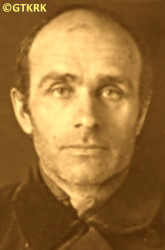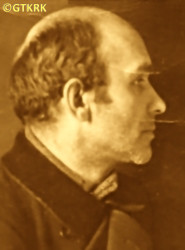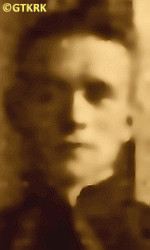Roman Catholic
St Sigismund parish
05-507 Słomczyn
85 Wiślana Str.
Konstancin deanery
Warsaw archdiocese, Poland
full list:
displayClick to display full list

searchClick to search full list by categories
wyświetlKliknij by wyświetlić pełną listę po polsku

szukajKliknij by przeszukać listę wg kategorii po polsku

Martyrology of the clergy — Poland
XX century (1914 – 1989)
personal data
surname
FILIPP
forename(s)
Adolph (pl. Adolf)

function
diocesan priest
creed
Latin (Roman Catholic) Church RCmore on
en.wikipedia.org
[access: 2014.09.21]
diocese / province
Mogilev archdiocesemore on
en.wikipedia.org
[access: 2013.06.23]
date and place
of death
04.11.1937

Vitebsktoday: Vitebsk reg., Belarus
more on
en.wikipedia.org
[access: 2023.01.18]
alt. dates and places
of death
27.08.1937
Minsktoday: Minsk city reg., Belarus
more on
en.wikipedia.org
[access: 2020.07.31]
details of death
For the first time arrested by the Russians on 03.11.1922.
Accused of illegal crossing the Polish–Russian border (it crossed over his parishes boundaries), of hoarding church valuables and anti–Russian propaganda.
Thanks to his parishioners intervention and witness statements released but forced to relocate to Polotsk.
Arrested again on 10.01.1927 in Vitebsk.
Accused of spying for Poland.
On 20.06.1927 sentenced to 10 years of slave labour.
On 08.10.1927 jailed in Solovetsky Islands concentration camp, where he slaved as a „gardener and road worker”.
In 07.1929 transported to Anzer Island concentration camp.
From there managed to smuggle out to Poland a letter, dated 29.06.1930 and addressed to Russian authorities, signed by 32 Catholic priests, describing terrible fate of priests on Solovetsky Islands.
In 1932 accused of ministering to the prisoners, i.e. „organisation of formal anti–Russian society”, and on 05.07.1932 had the sentence confirmed and despite prosecutor demanding single cell and total isolation in Yaroslav prison remained in concentration camp on Solovetsky Islands.
For a time held in a prison within a camp system.
In 10.11.1936 released.
Returned to Vitebsk.
In 08.1937 arrested again.
Accused of membership of Polish Military Organisation POW (a clandestine Polish organization in Russia active during World War I in 1914‐1918) and spying from 1925 for Poland.
On 20.10.1937 sentenced by «NKVD Troika» Russian genocidal kangaroo court — together with c. 112 other victims tried at the same time — to death and murdered in prison.
alt. details of death
Possibly tried and murdered in Minsk.
According to some sources arrested in 08.1937 in Vitebsk and exiled.
Fater thereafter unknown.
cause of death
mass murder
perpetrators
Russians
sites and events
Judicial murders 1937 MinskClick to display the description, 11.08.1937 Russian genocideClick to display the description, Great Purge 1937Click to display the description, MinskClick to display the description, Forced exileClick to display the description, Trial of 05.07.1932Click to display the description, OLP AnzerLagClick to display the description, GulagClick to display the description
date and place
of birth
05.01.1885

Zabołocielocation unclear
today: Lyepyel dist., Vitebsk reg., Belarus
presbyter (holy orders)
ordination
1909

positions held
1936 – 1937
priest — Vitebsktoday: Vitebsk reg., Belarus
more on
en.wikipedia.org
[access: 2023.01.18] ⋄ St Anthony RC church
1924 – 1927
administrator — Polotsktoday: Polotsk dist., Vitebsk reg., Belarus
more on
en.wikipedia.org
[access: 2023.01.18] ⋄ RC parish
till 1924
priest — Dryssatoday: Verkhnyadzvinsk, Verkhnyadzvinsk dist., Vitebsk reg., Belarus
more on
en.wikipedia.org
[access: 2022.07.16] ⋄ Nativity of the Blessed Virgin Mary RC parish — also ministering in the villages of Czeczersk (1924), Siebież, Oświa (1922‐1924)
c. 1919
curatus/rector/expositus — Zamoshetoday: non‐existent, Krulevshchina ssov., Dokshytsy dist., Vitebsk reg., Belarus
more on
pl.wikipedia.org
[access: 2022.01.06] ⋄ RC chapel ⋄ Dokshytsytoday: Dokshytsy dist., Vitebsk reg., Belarus
more on
en.wikipedia.org
[access: 2022.01.06], Holy Trinity RC parish
1912 – 1915
administrator — Lugatoday: Luga urban, Luga reg., Leningrad oblast, Russia
more on
en.wikipedia.org
[access: 2022.07.16] ⋄ St Nicholas the Bishop and Confessor RC parish ⋄ Sankt Petersburgtoday: Saint Petersburg city, Russia
more on
en.wikipedia.org
[access: 2020.07.31] RC deanery — prefect
c. 1912
curatus/rector/expositus — Luninetstoday: Luninets dist., Brest reg., Belarus
more on
en.wikipedia.org
[access: 2021.09.02] ⋄ RC church ⋄ RC parish
vicar — Poltavatoday: Poltava city rai., Poltava obl., Ukraine
more on
en.wikipedia.org
[access: 2022.02.15] ⋄ RC parish
1909 – 1911
curatus/rector/expositus — Belostokalso: Belostotskyi poselok
today: Krivosheino reg., Tomsk oblast, Russia
more on
en.wikipedia.org
[access: 2021.12.18] ⋄ St Anthony of Padua RC church ⋄ Tomsktoday: Tomsk city reg., Karelia rep., Russia
more on
en.wikipedia.org
[access: 2022.07.16], RC parish ⋄ Tomsktoday: Tomsk city reg., Karelia rep., Russia
more on
en.wikipedia.org
[access: 2022.07.16] RC deanery — minister to the Polish settlers in Siberia
1909 – 1911
curatus/rector/expositus — Malichevkaalso: Malichevskyi poselok
today: prob. non‐existent, Krivosheino reg., Tomsk oblast, Russia ⋄ St John the Baptist RC church ⋄ Tomsktoday: Tomsk city reg., Karelia rep., Russia
more on
en.wikipedia.org
[access: 2022.07.16], RC parish ⋄ Tomsktoday: Tomsk city reg., Karelia rep., Russia
more on
en.wikipedia.org
[access: 2022.07.16] RC deanery — minister to the Polish settlers in Siberia
till 1909
student — Sankt Petersburgtoday: Saint Petersburg city, Russia
more on
en.wikipedia.org
[access: 2020.07.31] ⋄ philosophy and theology, Metropolitan Theological Seminary
others related
in death
ANDREKUSClick to display biography Constantine, AWGŁOClick to display biography Peter, BOROWIKClick to display biography John, JACZEJKOClick to display biography Anthony, JANUKOWICZClick to display biography Peter, JAROSZEWICZClick to display biography Stanislav, KASZCZYCClick to display biography Adolph, KAZIUNASClick to display biography Paul, PRYTUŁŁOClick to display biography Alexander, RAJKOClick to display biography Stanislav, GRABOWSKIClick to display biography Francis, MICHASIONEKClick to display biography Nicholas
sites and events
descriptions
Judicial murders 1937 Minsk: In 1937 and 1938, during so‐called „Polish operation” — Russian genocide of Polish citizens in Russia — In Minsk, more precisely: in Belarus, a number of trials of Poles, accused of membership of Polish Military Organisation POW (a clandestine Polish organization in Russia active during World War I in 1914‐1918) and espionage for Poland. Altogether from 08.1937 till 09.1938 in Belarus 23,429 people, including 21,407 Poles, were arrested. Russian genocidal «NKVD Troika» kangaroo courts had mainly one sentence in their books: death by execution (in Ukraine alone during whole „ Polish operation” 61.77% of sentences were death sentences). Among others on 25.08.1937 in Minsk at least 7 Polish priests were sentenced to death: Fr Constantine Andrekus, Fr Peter Awgło, Fr John Borowikiem, Fr Peter Janukowicz, Fr Anthony Jaczejko, Fr. Alexander Prytułło and Fr Stanislav Rajko. On 20.10.1937 in Vitebsk Fr. Adolph Fillip was tried. On 22.10.1937 Fr Paul Kaziunas was sentenced. On the same day in Orsha Russians sentenced to death Fr Adolph Kaszczyc. And finally on 03.01.1938 Fr Stanislav Jaroszewicz was tried. All were murdered in Russian prisons. (more on: pamiec.plClick to attempt to display webpage
[access: 2019.02.02])
11.08.1937 Russian genocide: On 11.08.1937 Russian leader Stalin decided and NKVD head, Nicholas Jeżow, signed a «Polish operation» executive order no 00485. 139,835 Poles living in Russia were thus sentenced summarily to death. According to the records of the „Memorial” International Association for Historical, Educational, Charitable and Defense of Human Rights (Rus. Международное историко‐просветительское, правозащитное и благотворительное общество „Мемориал”), specialising with historical research and promoting knowledge about the victims of Russian repressions — 111,091 were murdered. 28,744 were sentenced to deportation to concentration camps in Gulag. Altogether however more than 100,000 Poles were deported, mainly to Kazakhstan, Siberia, Kharkov and Dniepropetrovsk. According to some historians, the number of victims should be multiplied by at least two, because not only the named persons were murdered, but entire Polish families (the mere suspicion of Polish nationality was sufficient). Taking into account the fact that the given number does not include the genocide in eastern Russia (Siberia), the number of victims may be as high as 500,000 Poles. (more on: en.wikipedia.orgClick to attempt to display webpage
[access: 2016.03.14])
Great Purge 1937: „Great Terror” (also «Great Purge», also called „Yezhovshchyna” after the name of the then head of the NKVD) — a Russian state action of political terror, planned and directed against millions of innocent victims — national minorities, wealthier peasants (kulaks), people considered opponents political, army officers, the greatest intensity of which took place from 09.1936 to 08.1938. It reached its peak starting in the summer of 1937, when Art. 58‐14 of the Penal Code about „counter‐revolutionary sabotage” was passed , which became the basis for the „legalization” of murders, and on 02.07.1937 when the highest authorities of Russia, under the leadership of Joseph Stalin, issued a decree on the initiation of action against the kulaks. Next a number of executive orders of the NKVD followed, including No. 00439 of 25.07.1937, starting the liquidation of 25,000‐42,000 Germans living in Russia (mainly the so‐called Volga Germans); No. 00447 of 30.07.1937, beginning the liquidation of „anti‐Russian elements”, and No. 00485[2] of 11.08.1937, ordering the murder of 139,835 people of Polish nationality (the latter was the largest operation of this type — encompassed 12.5% of all those murdered during the «Great Purge», while Poles constituted 0.4% of the population). In the summer of 1937 Polish Catholic priests held in Solovetsky Islands, Anzer Island and ITL BelbaltLag were locked in prison cells (some in Sankt Petersburg). Next in a few kangaroo, murderous Russian trials (on 09.10.1937, 25.11.1937, among others) run by so‐called «NKVD Troika» all were sentenced to death. They were subsequently executed by a single shot to the back of the head. The murders took place either in Sankt Petersburg prison or directly in places of mass murder, e.g. Sandarmokh or Levashov Wilderness, where their bodies were dumped into the ditches. Other priests were arrested in the places they still ministered in and next murdered in local NKVD headquarters (e.g. in Minsk in Belarus), after equally genocidal trials run by aforementioned «NKVD Troika» kangaroo courts.
Minsk: Russian prison. In 1937 site of mass murders perpetrated by the Russians during a „Great Purge”. After Russian invasion of Poland in 09.1939 and start of the World War II place of incarceration of many Poles, In 06.1941, under attack by Germans, Russians murdered there a group of Polish prisoner kept in Central and co‐called American prisons in Mińsk. The rest were driven towards Chervyen in a „death march” (10,000‐20,000 prisoners perished), into Russia. (more on: pl.wikipedia.orgClick to attempt to display webpage
[access: 2013.08.17])
Forced exile: One of the standard Russian forms of repression. The prisoners were usually taken to a small village in the middle of nowhere — somewhere in Siberia, in far north or far east — dropped out of the train carriage or a cart, left out without means of subsistence or place to live. (more on: en.wikipedia.orgClick to attempt to display webpage
[access: 2014.12.20])
Trial of 05.07.1932: Russian trial of Catholic priests held in Solovetsky Islands and Anzer Island, accused of „creation of an anti‐Russian group that conducted anti‐Russian agitation, clandestinely celebrated Mass and religious rites and maintained an illegal contact with a free worker for purposes of transmitting abroad information of an espionage character about the situation of Catholics in the Russia”. The prisoners were given prolonged sentences in concentration camp and spread them among the various Gułag camps.
OLP AnzerLag: Russian Rus. Отдельный лагерный пункт (Eng. Separate Camp Unit) OLP on the Anzer Island on White Sea. On the Island, 47 km2, belonging to Solovetsky Islands archipelago, Russians organised one of the first concentration camps in Russia (part of ITL SLON Solovetsky Islands concentratoin camp). In 1930s c. 32 Catholic priests were held there most of who perished. (more on: en.wikipedia.orgClick to attempt to display webpage
[access: 2014.12.20])
Gulag: The acronym Gulag comes from the Rus. Главное управление исправительно‐трудовых лагерей и колоний (Eng. Main Board of Correctional Labor Camps). The network of Russian concentration camps for slave labor was formally established by the decision of the highest Russian authorities on 27.06.1929. Control was taken over by the OGPU, the predecessor of the genocidal NKVD (from 1934) and the MGB (from 1946). Individual gulags (camps) were often established in remote, sparsely populated areas, where industrial or transport facilities important for the Russian state were built. They were modeled on the first „great construction of communism”, the White Sea‐Baltic Canal (1931‐1932), and Naftali Frenkel, of Jewish origin, is considered the creator of the system of using forced slave labor within the Gulag. He went down in history as the author of the principle „We have to squeeze everything out of the prisoner in the first three months — then nothing is there for us”. He was to be the creator, according to Alexander Solzhenitsyn, of the so‐called „Boiler system”, i.e. the dependence of food rations on working out a certain percentage of the norm. The term ZEK — prisoner — i.e. Rus. заключенный‐каналоармец (Eng. canal soldier) — was coined in the ITL BelBaltLag managed by him, and was adopted to mean a prisoner in Russian slave labor camps. Up to 12 mln prisoners were held in Gulag camps at one time, i.e. c. 5% of Russia's population. In his book „The Gulag Archipelago”, Solzhenitsyn estimated that c. 60 mln people were killed in the Gulag until 1956. Formally dissolved on 20.01.1960. (more on: en.wikipedia.orgClick to attempt to display webpage
[access: 2024.04.08])
sources
personal:
biographies.library.nd.eduClick to attempt to display webpage
[access: 2014.12.20], parafialugarosja.blogspot.comClick to attempt to display webpage
[access: 2014.12.20], cyclowiki.orgClick to attempt to display webpage
[access: 2019.02.02], pl.catholicmartyrs.orgClick to attempt to display webpage
[access: 2014.12.20], belarusguide.livejournal.comClick to attempt to display webpage
[access: 2019.02.02], ru.openlist.wikiClick to attempt to display webpage
[access: 2019.02.02], www.iwieniec.euClick to attempt to display webpage
[access: 2012.12.28]
bibliographical:
„Fate of the Catholic clergy in USSR 1917‐1939. Martyrology”, Roman Dzwonkowski, SAC, ed. Science Society KUL, 2003, Lublin
original images:
cyclowiki.orgClick to attempt to display webpage
[access: 2019.02.02], belarusguide.livejournal.comClick to attempt to display webpage
[access: 2019.02.02], pbc.biaman.plClick to attempt to display webpage
[access: 2019.05.30]
LETTER to CUSTODIAN/ADMINISTRATOR
If you have an Email client on your communicator/computer — such as Mozilla Thunderbird, Windows Mail or Microsoft Outlook, described at WikipediaPatrz:
en.wikipedia.org, among others — try the link below, please:
LETTER to CUSTODIAN/ADMINISTRATORClick and try to call your own Email client
If however you do not run such a client or the above link is not active please send an email to the Custodian/Administrator using your account — in your customary email/correspondence engine — at the following address:

giving the following as the subject:
MARTYROLOGY: FILIPP Adolph
To return to the biography press below:
 Click to return to biography
Click to return to biography










